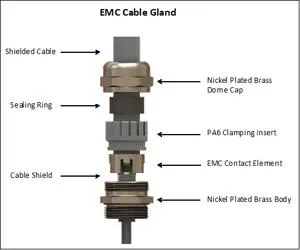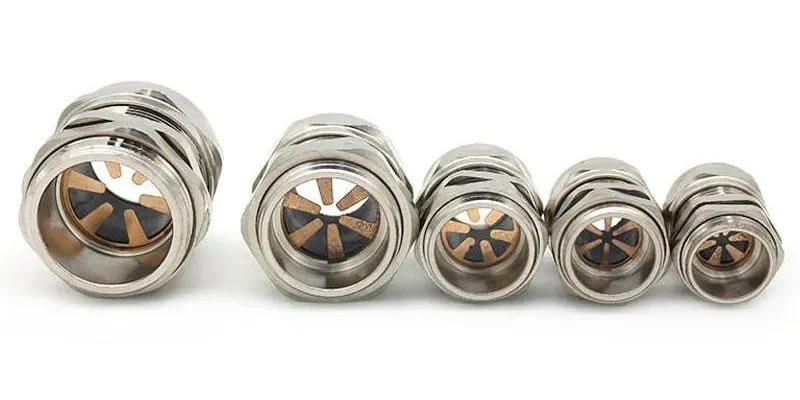Dławnice kablowe EMC to specjalistyczne urządzenia zaprojektowane w celu ochrony sprzętu elektrycznego przed zakłóceniami elektromagnetycznymi, zapewniając jednocześnie bezpieczne połączenia kablowe. Komponenty te odgrywają kluczową rolę w utrzymaniu kompatybilności elektromagnetycznej w różnych zastosowaniach przemysłowych i technologicznych, od telekomunikacji po systemy inżynierii medycznej.
Czym są dławiki kablowe EMC?
Dławiki kablowe EMC to mechaniczne przepusty kablowe, które służą jako krytyczne elementy zabezpieczające systemy elektryczne przed zakłóceniami elektromagnetycznymi (EMI). Te wyspecjalizowane dławnice tworzą bezpieczne połączenie między kablami i obudowami urządzeń, zapewniając kompatybilność elektromagnetyczną (EMC) w różnych środowiskach technologicznych. Dzięki zastosowaniu 360-stopniowego połączenia ekranującego i metalowych elementów stykowych, które łączą się z plecionym ekranem kabla, dławiki kablowe EMC skutecznie zarządzają falami elektromagnetycznymi, kierując je do uziemienia i zapobiegając zakłóceniom wrażliwych elementów elektronicznych.
Komponenty i konstrukcja

- Główny korpus: Zwykle wykonany z niklowanego mosiądzu lub stali nierdzewnej, zapewniający wsparcie strukturalne i przewodność.
- Nakrętka dławika: Zabezpiecza przewód na miejscu i tworzy szczelne uszczelnienie.
- Przewodząca sprężyna lub element stykowy: Zapewnia 360-stopniowy kontakt z plecionym ekranem kabla.
- Wkładka uszczelniająca: Często wykonana z neoprenu lub poliamidu, chroni przed wnikaniem czynników środowiskowych.
- Wkładka zaciskowa: Zapewnia odciążenie i utrzymanie kabla.
Taka konstrukcja sprawia, że dławiki kablowe EMC skutecznie chronią przed zakłóceniami elektromagnetycznymi, oferując jednocześnie stopień ochrony IP68 przed wnikaniem pyłu i wody. Konstrukcja umożliwia szybki montaż i bezpieczną instalację, dzięki czemu idealnie nadają się do różnych zastosowań przemysłowych i technologicznych wymagających solidnej ochrony EMC.
Kluczowe funkcje i ochrona
Dławiki kablowe EMC są wykonane z wytrzymałych materiałów, takich jak mosiądz lub stal nierdzewna, zaprojektowanych tak, aby wytrzymać trudne warunki środowiskowe. Urządzenia te oferują kompleksową ochronę w imponującym zakresie temperatur pracy od -40°C do 120°C i stopniu ochrony IP68, zapewniając odporność na wilgoć, płyny, korozję i wnikanie pyłu. Konstrukcja dławnic obejmuje zazwyczaj trzy główne elementy:
- Mocowanie zapewniające bezpieczne mocowanie
- Wkładka uszczelniająca do ochrony kabli
- Nakrętka kołpakowa do ściskania i uszczelniania
Konstrukcja ta nie tylko zapewnia ekranowanie RFI/EMI, ale także oferuje funkcje przewodzące, dzięki czemu dławiki kablowe EMC są niezbędne do utrzymania integralności sygnału i ochrony wrażliwego sprzętu elektronicznego w różnych zastosowaniach przemysłowych i technologicznych.
Zastosowania w różnych branżach
Dławiki kablowe EMC znajdują szerokie zastosowanie w różnych gałęziach przemysłu ze względu na ich kluczową rolę w utrzymaniu kompatybilności elektromagnetycznej. Te wyspecjalizowane urządzenia są niezbędnymi komponentami w:
- Sprzęt telekomunikacyjny zapewniający wyraźną transmisję sygnału
- Systemy inżynierii medycznej, chroniące wrażliwe urządzenia diagnostyczne i terapeutyczne
- Konfiguracje automatyki przemysłowej, zabezpieczające systemy sterowania przed zakłóceniami
- Pojazdy elektryczne i hybrydowe, utrzymanie integralności elektroniki pokładowej
- Systemy nadzoru, zachowujące jakość wideo i danych
- Moduły fotowoltaiczne, ochrona falowników i sprzęt monitorujący
- Systemy dystrybucji energii, zapewniające niezawodny przesył energii
Wszechstronność dławików kablowych EMC sprawia, że są one niezbędne w środowiskach, w których zakłócenia elektromagnetyczne mogą zagrozić funkcjonalności sprzętu lub integralności danych. Ich wdrożenie pomaga utrzymać wydajność operacyjną i niezawodność w tych różnorodnych sektorach.
Zasada działania i korzyści
Działając na zasadzie klatki Faradaya, dławiki kablowe EMC skutecznie odbijają fale elektromagnetyczne na powierzchni obudowy, chroniąc odsłonięte kable wewnątrz. Gdy izolowany kabel wchodzi do dławika, jego metalowy styk łączy się z metalową siatką izolacyjną kabla, kierując fale zakłóceń elektromagnetycznych do linii uziemienia i usuwając źródło zakłóceń.
Wdrożenie tych wyspecjalizowanych gruczołów oferuje liczne korzyści, w tym:
- Ochrona wrażliwych komponentów elektronicznych przed zakłóceniami elektromagnetycznymi
- Ciągłe zaciskanie z odpowiednią odpornością na wyrywanie
- Utrzymanie integralności sygnału i zasilania
- Zwiększona ochrona na krytycznych przejściach do obudów
Korzyści te zapewniają bezawaryjne działanie maszyn i systemów, dzięki czemu dławiki kablowe EMC są kluczowym elementem rozwiązań w zakresie ekranowania elektromagnetycznego.
Wytyczne dotyczące instalacji dławików kablowych EMC
Prawidłowa instalacja dławików kablowych EMC ma kluczowe znaczenie dla zapewnienia optymalnej kompatybilności elektromagnetycznej i ochrony. Proces ten zazwyczaj obejmuje następujące kluczowe kroki:
- Wybierz odpowiedni dławik kablowy EMC w oparciu o średnicę kabla, warunki środowiskowe i wymagany poziom ochrony.
- Przygotuj kabel, zdejmując zewnętrzną powłokę, aby odsłonić ekran, zwykle 5-10 mm.
- Przełóż kabel przez dławik, upewniając się, że sprężyny uziemiające stykają się z odsłoniętym ekranem.
- Przymocuj dławik do obudowy za pomocą nakrętki zabezpieczającej, tworząc szczelne uszczelnienie.
- Dokręć nasadkę, aby ustalić przewodność, uważając, aby nie dokręcić zbyt mocno ani nie obrócić kabla, co mogłoby spowodować jego uszkodzenie.
Podczas instalacji należy bezwzględnie przestrzegać wytycznych producenta i odpowiednich kodeksów postępowania. Prawidłowa instalacja zapewnia skuteczną ochronę EMI, utrzymuje integralność uszczelnienia obudowy i zapewnia odpowiednie odciążenie kabla.
Dowiedz się więcej na Youtube
Porównanie ze standardowymi dławikami kablowymi
Dławiki kablowe EMC zapewniają lepszą ochronę elektromagnetyczną w porównaniu ze standardowymi dławikami kablowymi, co czyni je niezbędnymi w zastosowaniach wrażliwych na zakłócenia elektromagnetyczne. Podczas gdy standardowe dławiki kablowe zapewniają przede wszystkim ochronę środowiskową i odciążenie, dławiki EMC posiadają dodatkowe funkcje:
- Materiały przewodzące, takie jak niklowany mosiądz lub stal nierdzewna, zapewniają skuteczne ekranowanie.
- 360-stopniowy kontakt z plecionym ekranem kabla, zapewniający ciągłą ochronę przed zakłóceniami elektromagnetycznymi.
- Wyższe wartości tłumienia, szczególnie w górnym zakresie częstotliwości
- Większa obciążalność prądowa dla niezawodnego rozładowywania dużych prądów osłonowych
Te cechy sprawiają, że dławiki kablowe EMC są bardziej odpowiednie do środowisk o znacznych zakłóceniach elektromagnetycznych, takich jak automatyka przemysłowa, telekomunikacja i instalacje sprzętu medycznego. Są one jednak generalnie droższe i mogą wymagać bardziej precyzyjnej instalacji niż standardowe dławnice kablowe.
Powiązany artykuł:
Mosiężny dławik kablowy z gwintem PG



